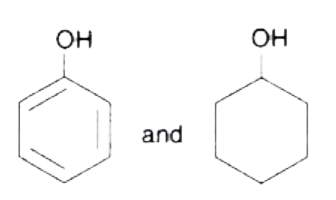Give the chemical tests between the following pairs:
Iron (II) sulphate and Iron (III) sulphate.
To differentiate between Iron (II) sulfate (FeSO₄) and Iron (III) sulfate (Fe₂(SO₄)₃), we can perform a chemical test using ammonium hydroxide (NH₄OH). Here’s a step-by-step solution:
Step 1: Prepare the Solutions
- Take a small amount of Iron (II) sulfate (FeSO₄) in a test tube.
- In another test tube, take a small amount of Iron (III) sulfate (Fe₂(SO₄)₃).
Step 2: Add Ammonium Hydroxide
- To the Iron (II) sulfate solution, add a few drops of ammonium hydroxide (NH₄OH).
- Observe the reaction and the resulting precipitate.
Step 3: Observe the Precipitate for Iron (II) Sulfate
- Upon adding NH₄OH to Iron (II) sulfate, a dirty green precipitate of ferrous hydroxide (Fe(OH)₂) will form.
- This precipitate is insoluble in excess ammonium hydroxide.
Step 4: Add Ammonium Hydroxide to Iron (III) Sulfate
- Now, to the Iron (III) sulfate solution, add a few drops of ammonium hydroxide (NH₄OH).
- Observe the reaction and the resulting precipitate.
Step 5: Observe the Precipitate for Iron (III) Sulfate
- When NH₄OH is added to Iron (III) sulfate, a reddish-brown precipitate of ferric hydroxide (Fe(OH)₃) will form.
- This precipitate is also insoluble in excess ammonium hydroxide.
Conclusion
- The key difference between the two tests is the color of the precipitate formed:
- Iron (II) sulfate gives a dirty green precipitate (Fe(OH)₂).
- Iron (III) sulfate gives a reddish-brown precipitate (Fe(OH)₃).
- Take a small amount of Iron (II) sulfate (FeSO₄) in a test tube.
- In another test tube, take a small amount of Iron (III) sulfate (Fe₂(SO₄)₃).
- To the Iron (II) sulfate solution, add a few drops of ammonium hydroxide (NH₄OH).
- Observe the reaction and the resulting precipitate.
- Upon adding NH₄OH to Iron (II) sulfate, a dirty green precipitate of ferrous hydroxide (Fe(OH)₂) will form.
- This precipitate is insoluble in excess ammonium hydroxide.
- Now, to the Iron (III) sulfate solution, add a few drops of ammonium hydroxide (NH₄OH).
- Observe the reaction and the resulting precipitate.
- When NH₄OH is added to Iron (III) sulfate, a reddish-brown precipitate of ferric hydroxide (Fe(OH)₃) will form.
- This precipitate is also insoluble in excess ammonium hydroxide.
- The key difference between the two tests is the color of the precipitate formed:
- Iron (II) sulfate gives a dirty green precipitate (Fe(OH)₂).
- Iron (III) sulfate gives a reddish-brown precipitate (Fe(OH)₃).
Topper's Solved these Questions
- SAMPLE QUESTION PAPER 5BOOK - ICSECHAPTER - SAMPLE QUESTION PAPER 5EXERCISE - Section I(Choose the correct answer)
5 Videos
- SAMPLE QUESTION PAPER 5BOOK - ICSECHAPTER - SAMPLE QUESTION PAPER 5EXERCISE - Section II
35 Videos
- SAMPLE QUESTION PAPER 03BOOK - ICSECHAPTER - SAMPLE QUESTION PAPER 03EXERCISE - SECTION II
47 Videos
- SELF ASSESSMENT PAPER 05BOOK - ICSECHAPTER - SELF ASSESSMENT PAPER 05EXERCISE - SECTION II (Fill in the blanks with the choice given in the brackets. )
5 Videos
Similar Questions
Give the chemical tests distinguish between the following pairs:
Copper sulphate and Iron (II) sulphate.
View SolutionGive the chemical tests between the following pairs:
A lead salt and a zinc salt.
View SolutionGive a chemical test to distinguish between the following:
Sodium sulphate and ammonium sulphate.
View SolutionHow will you distinguish between following pairs of compounds using NH4OH.
Iron(II) sulphate and iron(III) sulphate.
View SolutionGive a chemical test to distinguish between the following pairs of compounds:

View SolutionGive one chemical test to distinguish between the following pairs of compounds.
Iron (II) chloride solution and Iron (III) chloride solution.
View SolutionThe formula of iron (III) sulphate is
View SolutionGive a chemical test to distinguish between the following pairs of compounds:
Sodium sulphate and sodium sulphite.
View SolutionGive one chemical test to distinguish between the following pairs of compounds.
Zinc sulphate solution and Zinc chloride solution.
View SolutionDistinguish between the following pairs of compounds · using test given within brackets :
Iron (II) sulphate and iron (III) sulphate (using ammonium hydroxide)
View Solution
